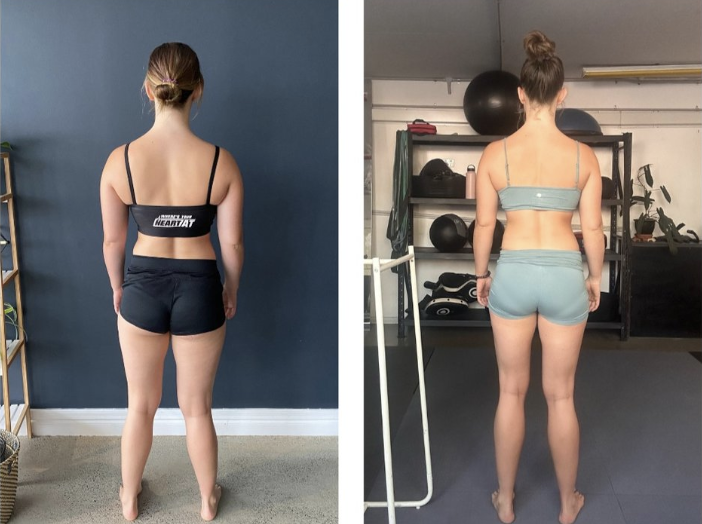My Experience With Fascia Blasting & Fascia Stretching
Before: Using Fascial Blasting & Seeing No Result → After: Using Functional Patterns & Restoring My Fascial Health
Hi, I’m Keriann, a Human Biomechanics Consultant and Trainer, here to share my insights and clinical experiences with fascia treatments like blasting and stretching.
Initially, these methods seem to offer relief. If your fascia feels tight and knotted, why not try blasting or stretching it out?
However, working in a movement-based clinic, I see many clients who’ve tried these techniques. Despite using massage guns, blasting tools, and stretching, they’re still dealing with persistent fascial pain.
Here’s why I moved away from fascia blasting.
A Quick Guide to Fascia and Popular Treatments Like Blasting and Stretching
Fascia is a connective tissue surrounding muscles, bones, and organs, playing a vital role in our body’s movement and function. This intricate network not only supports our structure but also aids mobility and posture.
The health of this tissue is crucial for pain-free movement. As more people recognise its importance, approaches like fascia blasting and stretching have gained popularity. They’re touted as solutions for pain relief, flexibility improvement, and even enhanced appearance. However, examining their long-term effects reveals a different picture.
Fascia blasting involves using tools like massage guns or the Ashley Black fascia blaster to apply pressure, break up adhesions, reduce cellulite, ease pain, and increase flexibility. Similarly, fascia stretching aims to release tension and boost flexibility by lengthening the tissue.
Some proponents claim fascia blasting increases blood flow, reduces fat under the skin, and supports your fascia layers. Many positive reviews have fueled its popularity. But let’s look at the longer-term impacts of targeting fascia and connective tissue with these methods.
Why Fascia Blasting and Stretching Fall Short
While blasting and stretching might offer immediate relief, these effects are typically short-lived, without addressing deeper movement issues. This article explores why blasting and stretching are limited solutions and suggests a more integrated approach to improving fascial health.
My Experience with Fascia Blasting
Like many, I was initially drawn to fascia blasting to address pain, movement limitations, and even improve skin texture. I used a massage gun around three times a week.
The fast results and ease of using a massage gun at the gym were appealing, and I hoped for lasting improvements. At first, the temporary effects were positive, with some increased mobility. But looking back, I now recognize that my flexibility was already excessive, and this routine was masking more significant issues.
The convenience and cost savings initially made fascia blasting seem like an ideal solution. However, this regular practice led me to see the limitations of treating the fascia in isolation from my overall movement patterns.
The Functional Patterns Approach to Fascia Health
At Burleigh Biomechanics, we use Functional Patterns (FP) methodology, which views the body as a connected system. FP emphasises training for real-life movement, not just isolated muscle exercises.
This approach differs from conventional methods like fascia blasting and stretching. FP aims to address the root causes of dysfunction rather than just the symptoms. By understanding the body as an interconnected system, FP works on rebalancing movement patterns that contribute to pain, stiffness, and limitations in the first place.
This comprehensive approach seeks long-term relief through retraining movement, making FP a sustainable alternative to the temporary fixes that fascia blasting and stretching provide. While blasting may appear to break up adhesions on the surface, it doesn’t address the deeper factors that cause them.
Fascia stretching might temporarily boost superficial flexibility, but it doesn’t create the stability required for long-term health. In contrast, FP helps you move as a coordinated unit, preventing the compensation patterns that lead to fascial issues.
Understanding the Limitations of Fascia Blasting and Stretching
Although blasting and stretching may provide quick symptom relief, they’re typically used in isolation and fail to address the body’s underlying imbalances. This often leads to a cycle of repetitive treatments without real improvement. Fascial tension frequently results from deeper issues, like dehydration or lack of stability.
Short-term solutions like blasting and stretching can lead to greater reliance on these methods while failing to correct the root causes of fascial tightness and discomfort.
How Functional Patterns Addresses Root Causes
Functional Patterns approaches fascial health by targeting the movement dysfunctions that lead to fascia issues in the first place. This approach aims for lasting results by teaching the body to operate optimally, reducing strain on the fascia and improving posture, mobility, and overall health.
Instead of focusing on symptoms, Functional Patterns aims to restore function by addressing the movement imbalances causing fascial tightness. Correcting these imbalances leads to more durable results and an improvement in daily movement patterns, preventing future discomfort.
My Shift from Fascia Blasting to Functional Patterns
Moving from fascia blasting to Functional Patterns was transformative. Initially, I was drawn to blasting’s quick results, but the temporary relief led me to seek more sustainable solutions. Functional Patterns offered not just symptom relief but also a comprehensive improvement in my movement.
The transition wasn’t instant—it required me to embrace patience and persistence. Correcting dysfunctional movement patterns takes time, but the results were profound. FP helped me develop strength and true functional mobility, not just hyper-flexibility.
Functional Patterns has brought me long-lasting changes, and I’m grateful for the shift from temporary solutions to sustainable movement health.

